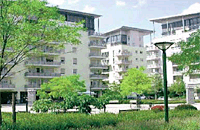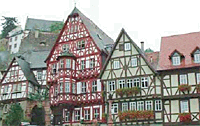Topic 2: Cultural Geography of Germany

Lesson 6: In what types of homes do Germans live?
Lesson Objective
The student will identify types of homes found in Germany.
Materials and Resources
 Transparency 10 - “Homes in Germany” |
 Transparency 11 - “Half-Timber Buildings” |
- Handout 5 - “Homes in Germany”
- Handout 6 - “Half-Timber Buildings”
- Handout 7 - “Diagram and Description of Half-Timber Structures”
Strategies
Germany is very crowded compared to the United States. To help students understand the high population density, explain that Germany is approximately the same size, geographically, as the state of Montana. If all the people living west of the Mississippi River (except California) moved to Montana, the state would be very crowded – as crowded as Germany is today. As Germany is so crowded, land is scarce and costly, building houses much more expensive than in the United States. Almost 60 percent of all Germans rent apartments or houses. Many new apartment buildings are being constructed (more people can live on less land), but they are small by U.S. standards. Approximately 40 percent of Germans own an apartment or single-family house, some of which have been passed from generation to generation. New houses are also being built on the outskirts of cities in places where pastures used to be. The land often costs as much as the house itself. Therefore, only wealthier Germans have built new homes recently. Germans who cannot afford a house frequently buy a condominium and are able to enjoy most of the conveniences of a house. Many people, about 20 percent of all Germans, live in small towns with a population of 10,000 or less. Their farm houses have generally been improved and remodeled to keep pace with new homes. Houses differ in appearance according to architectural style and use of building materials in various parts of Germany. In northern Germany, most houses are built with brick and many have thatched roofs. In central Germany, most houses have redtiled roofs. In central and southern Germany there are many half-timbered houses. Houses in the Black Forest region have steeply sloping roofs to prevent snow from collecting on the roof. Regardless of where they live, Germans decorate their homes and yards with flowers. Small lawns, both front and back, are usually fenced.
Distribute Handout 5 “Homes in Germany” and, for each photograph, have students identify the type of home (apartment, condominium, single-family home, etc.) and the location of the home (northern Germany, southern Germany, etc.):
| Photograph 1 – | Condominiums, Frankfurt (Hesse) Since the 1980s condominiums have been surrounded by generously designed parks and the apartments have modern steel and glass constructions. |
| Photograph 2 – | Suburban homes, Kassel (Hesse) There are suburbs even in towns of a medium size like Kassel with streets lined with small houses of the 18th and 19th century. |
| Photograph 3 – | Modernized apartment blocks from the 1970s, Haldesleben (Saxony - Anhalt) Apartment blocks from the 1970s were modernized and painted with different colours to make them more attractive. |
| Photograph 4 – | Terraced houses, Cologne (North - Rhine Westphalia) One of the favourite models of houses with gardens and garages in German suburbs. |
| Photograph 5 – | Single-family house, Pinnow (Mecklenburg – Western Pomerania) Red bricks are typical for the architecture of suburban single-family homes in northern Germany. |
| Photograph 6 – | Urban Art Nouveau house, Bonn (North - Rhine Westphalia) Richly designed architecture around 1900. |
| Photograph 7 – | Postmodern apartments, Bonn Design of the 1990s with steel and glass constructions |
| Photograph 8 – | Wilhelminian single - and multifamily residences, Bonn Favourite architecture at the end of the 19th century. |
| Photograph 9 – | Residential estate – Munich Estate design between the 1930s and ´50s, according to the Volkswagen concept: a car for every family, a house for every family. |

 Printable PDF
Printable PDF